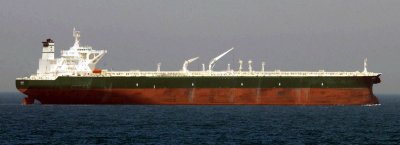Then three thoughts occurred to me: 1) a very large amount of the world’s freshwater is lost in the form of rain that falls at sea; 2) meanwhile, enormous petroleum supertankers ply those very same seas; 3) in some places, people pay more per liter for bottled water than they do for gasoline.
These thoughts were synthesized into a pretty freakin’ awesome idea: deploy a fleet of supertankers harvesting rainwater. They would use weather radar to hunt the heaviest precipitation (and the stormiest seas, like as not — only the hardiest sailors need apply). Any rain falling on their decks could be funneled straight into the holding tanks. I’m not sure how you’d keep seawater out of the tanks, as waves would frequently break over the deck of the ship in stormy seas, but that seems like a surmountable engineering detail.

Does it make economic sense to harvest rainwater this way? Let’s start by assuming it’s economical to transport petroleum by supertanker. (A safe assumption.) The retail price of a gallon of gasoline here in Northern California is presently right around three dollars. I don’t know how much crude oil goes into a gallon of gasoline, but for our very rough calculations it’s simplest and safe to say a gallon of gasoline equals a gallon of crude.
That three dollars per gallon we pay at the pump has to cover a lot of oil-industry expenses that a freshwater industry would not have: refineries, research, exploration, and drilling, not to mention giant slush funds for dealing with corrupt foreign regimes. And oil-industry tankers must be double-hulled to protect against spills. Freshwater tankers can be single-hulled.
On the other hand, whereas the oil industry can use their supertankers simply to transport millions of barrels of oil from one place directly to another, a freshwater fleet would have to roam at sea for a while until it contained enough water to make a delivery. This is an operational expense the oil industry does not have. How long must a freshwater supertanker follow rainstorms around until it is full? According to Wikipedia, a supertanker named the TI Asia has a depth (height) of 112 feet. Let’s guess that the tanks it contains are 60 feet high. For simplicity, let’s further assume these tanks have a uniform width — they don’t taper at the bottom or anything like that. This means that the ship must collect 60 feet of rain to fill its tanks — possibly less if a catch area much wider than the tanks themselves can be funneled into them. How long would it take to collect that much rain, if you’re always steering into the heaviest rainfall? Let’s guess that a good freshwater supertanker captain can expect an average of four inches of rain per day. That’s six months at sea to fill the freshwater tanks.
How much does it cost to have a supertanker crisscrossing the bounding main for six months? I have no idea, but let’s keep guessing and say that that cost roughly offsets the petroleum-industry-only costs I listed above (drilling, bribes, etc). This means that the fleet could deliver freshwater for about three dollars per gallon, which is about 79 cents per liter, which is very reasonable compared to the prices paid per liter of bottled water in many places threatened by future global-warming droughts.
The TI Asia can carry half a billion gallons of oil. If a comparable freshwater supertanker can carry an equal volume of water (which is not certain, since water is heavier than oil), then it can deliver a year’s worth of drinking water for a million people. Half a billion gallons is also equal to 1,534 acre-feet, enough water to irrigate 736 acres of crops for a year, but that sounds much less impressive, and at a cost of almost a million dollars per acre-foot, it’s nowhere near competitive.
Would I like to be the admiral of a fleet of freshwater supertankers saving the world? Hell yeah. For many weeks after this idea came to me, I kept it to myself. But then I looked at my pile of ideas-to-implement-someday, and the large subset of those that are in the category no-idea-how-to-get-started (which includes this one), and decided the world needs this idea more than I do. So, one of you reading this: get started. Just do me a favor and christen the first ship the gee bobg.
What, no song lyrics?
“We come on the gee bobg,
My grandfather and me,
…”